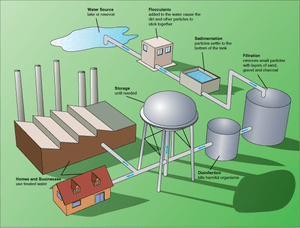Water treatment facts for kids
Water treatment is like cleaning water so it's safe and ready to use. It gets rid of things that shouldn't be in the water, or lowers how much of them there is. This makes the water perfect for what people need it for.
This is super important for our health, so we can drink water safely and use it to water plants. Factories also need very clean water for making steam or special products. Sometimes, this water has to be super pure, with almost no other chemicals in it.
Cleaning up wastewater so it doesn't harm the environment is another important part of water treatment.
Contents
How is water made safe to drink?
Drinking water is cleaned using special chemicals. These chemicals help remove tiny living things like bacteria, algae, viruses, and fungi. They also get rid of minerals such as iron and manganese.
Sometimes, water that comes to homes, like tap water, gets even more treatment before it's used. This can happen right in the pipes. For example, water might be made softer or have certain minerals removed.
What is wastewater treatment?
"Wastewater treatment" often means "sewage treatment." This is about cleaning water that has been used and now has waste in it. Common steps include separating solids, using biological processes (like tiny living things eating waste), and chemical processes.
The main goal is to make the treated wastewater safe enough to put back into nature or even use again.
How do industries clean their water?
Industries use different ways to clean their water before sending it out or reusing it. One way is called physical treatment. This method separates solid bits from the liquid in industrial wastewater.
Two common ways to do this are Filtration and Dissolved air flotation. Filtration uses special Membranes or filters to separate solids from liquids.
Dissolved air flotation works by pumping air under pressure into the wastewater. This creates tiny bubbles that stick to the solid waste. The bubbles then float the waste to the top, where it can be easily removed.
How is water disinfected?
For the past 20 years, a method called Ultraviolet (UV) disinfection has been used. This way of cleaning water doesn't use harmful chemicals.
UV light in a specific range (called UV-C) is used for disinfection. When UV-C light hits tiny germs, it damages their DNA. This stops them from being able to reproduce or cause harm.
Images for kids
See also
 In Spanish: Tratamiento de aguas para niños
In Spanish: Tratamiento de aguas para niños
- How to control water pollution
- Clean Water Act
- Peak water (about water supply and demand)
- Pulsed-power water treatment
- Solar water disinfection
- Treating raw water
- Water purification
- Water quality
- Water softening
- Water supply





